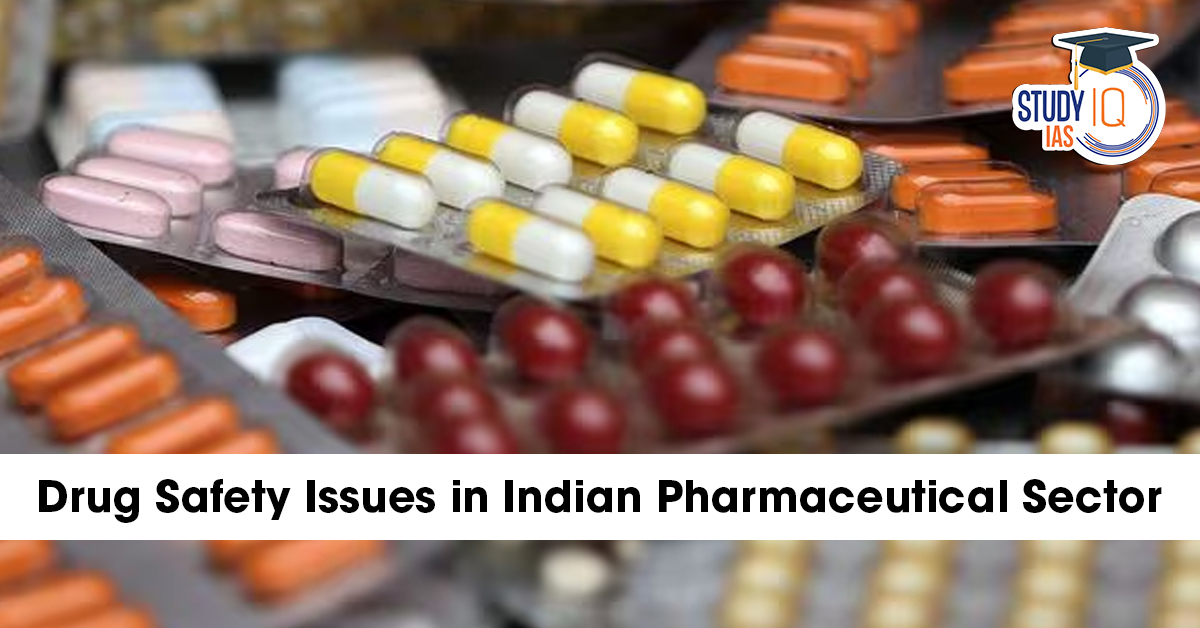Table of Contents
India, known as the “Pharmacy of the World”, supplies affordable medicines to over 200 countries. With a global share of nearly 20% in generic drug exports, the Indian pharmaceutical industry has built a reputation for accessibility and affordability.
However, drug safety issues — including reports of contaminated cough syrups, tainted eye drops, and substandard anaesthetics — have recently raised serious concerns about quality control and regulatory oversight in the Indian pharma sector.
These incidents have sparked global scrutiny from the World Health Organization (WHO) and foreign regulators, putting India’s pharmaceutical credibility at risk.
Major Drug Safety Controversies
1. Cough Syrup Tragedies
-
In 2022, the WHO linked 70 child deaths in Gambia to Indian-made cough syrups contaminated with diethylene glycol (DEG) and ethylene glycol (EG) — toxic industrial solvents.
-
Similar cases were reported in Uzbekistan, killing 18 children, and in Marshall Islands and Micronesia, identified by Australian authorities.
2. Eye Drops Contamination
-
Indian-manufactured eye drops caused blindness in 10 patients and eye infections in 30 others in Sri Lanka.
-
In the United States, the CDC detected drug-resistant bacteria in Indian eye drops that led to multiple deaths.
3. Anaesthetic Drug Deaths
-
Two patients in Sri Lanka died after being administered Indian-made anaesthetic drugs, marking another instance of compromised drug safety.
The Scale of the Indian Pharmaceutical Industry
-
3rd largest globally by volume, 13th by value.
-
Exports worth ₹1.75 lakh crore (FY 2021–22).
-
Houses 3,000+ pharma companies and 10,000+ manufacturing units.
-
Supplies 60% of global vaccines and 20% of generic drugs worldwide.
While these numbers highlight India’s pharmaceutical might, they also underline the critical need for strong quality assurance mechanisms.
Key Drug Safety Issues
1. Lack of Robust Regulatory Oversight
-
India’s regulatory system, led by the Central Drugs Standard Control Organization (CDSCO), has often been criticized for inadequate inspections and poor transparency.
-
There are inconsistencies in state-level drug control, resulting in uneven enforcement of safety standards.
2. Substandard and Spurious Drugs
-
According to a CDSCO survey (2014–2016), 5% of Indian drugs failed quality tests, and independent studies suggest the figure could be higher.
-
Some drugs contained incorrect dosages, impurities, or unapproved ingredients, posing severe health risks.
3. Export Quality vs Domestic Standards
-
Drugs manufactured for export often face stricter quality checks, whereas domestic drugs may not undergo the same level of scrutiny.
-
This dual standard undermines public trust and global confidence.
4. Dependence on Imported Raw Materials
-
India imports over 60% of its Active Pharmaceutical Ingredients (APIs), mainly from China.
-
Any compromise in imported materials can cascade into final drug safety issues.
5. Weak Post-Market Surveillance
-
India lacks a strong pharmacovigilance system to track adverse drug reactions (ADRs).
-
Many cases go unreported or unaddressed, limiting accountability.
Regulatory Framework for Drug Safety in India
1. Drugs and Cosmetics Act, 1940
-
Regulates manufacture, import, and distribution of drugs.
-
Ensures drugs are safe, effective, and of standard quality.
-
2008 Amendment: Introduced stricter penalties for manufacturing or selling spurious/adulterated drugs.
2. Central Drugs Standard Control Organization (CDSCO)
-
India’s national regulatory authority under the Ministry of Health and Family Welfare.
-
Oversees drug approvals, clinical trials, and quality checks.
3. Drugs Controller General of India (DCGI)
-
Head of CDSCO.
-
Approves new drugs, vaccines, and blood products.
-
Sets standards for manufacturing and sales.
4. New Drugs, Medical Devices and Cosmetics Bill, 2022
-
Aims to replace the 1940 Act and modernize the legal framework.
-
Proposes digital recordkeeping, device regulation, and stricter penalties for safety violations.
Reasons Behind Drug Safety Challenges
| Factor | Description |
|---|---|
| Regulatory Gaps | Limited manpower and fragmented coordination between central and state drug controllers. |
| Economic Pressures | Manufacturers often compromise on quality to maintain low production costs. |
| Inadequate Testing Facilities | Shortage of accredited labs for routine drug quality verification. |
| Lack of Transparency | Inspection reports and test results are not always made public. |
| Weak Enforcement | Penalties for violations are often delayed or insufficient. |
Global Implications
Repeated international safety alerts could:
-
Damage India’s export reputation.
-
Lead to foreign import restrictions or bans.
-
Reduce global trust in Indian generics, which many developing countries depend on.
Government Initiatives to Ensure Drug Safety
-
Pharma Vision 2020:
Aims to make India a global leader in end-to-end drug manufacturing. -
Production Linked Incentive (PLI) Scheme:
Encourages domestic API production to reduce dependency on imports. -
Pharmacovigilance Programme of India (PvPI):
Strengthens monitoring of adverse drug reactions. -
Quality Control Reforms:
Plans to introduce a centralized online database for all approved drugs and manufacturing facilities.
Way Forward
-
Transparent Regulatory System:
Publish inspection findings, test reports, and licensing decisions online for public scrutiny. -
Uniform Standards for Domestic & Export Drugs:
All drugs, regardless of destination, must pass identical quality tests. -
Stronger Surveillance:
Implement real-time post-market tracking of drug performance and safety. -
Encourage R&D and Innovation:
Promote research on drug formulation, bioequivalence, and safety testing. -
Global Collaboration:
Partner with WHO, USFDA, EMA, and other regulators for mutual audits and compliance benchmarking.
Conclusion
India’s pharmaceutical success story is built on affordability and accessibility — but drug safety must now be its top priority.
Becoming a true “Pharmacy of the World” demands not just low-cost production, but also world-class quality and integrity.
To restore global confidence, the Indian government and the pharma industry must work together to ensure every pill made in India is safe, effective, and trustworthy.


 World Summit on Disaster Management (WSD...
World Summit on Disaster Management (WSD...
 Domestic Systemically Important Banks (D...
Domestic Systemically Important Banks (D...
 The Missing Link in India’s Critical M...
The Missing Link in India’s Critical M...

























